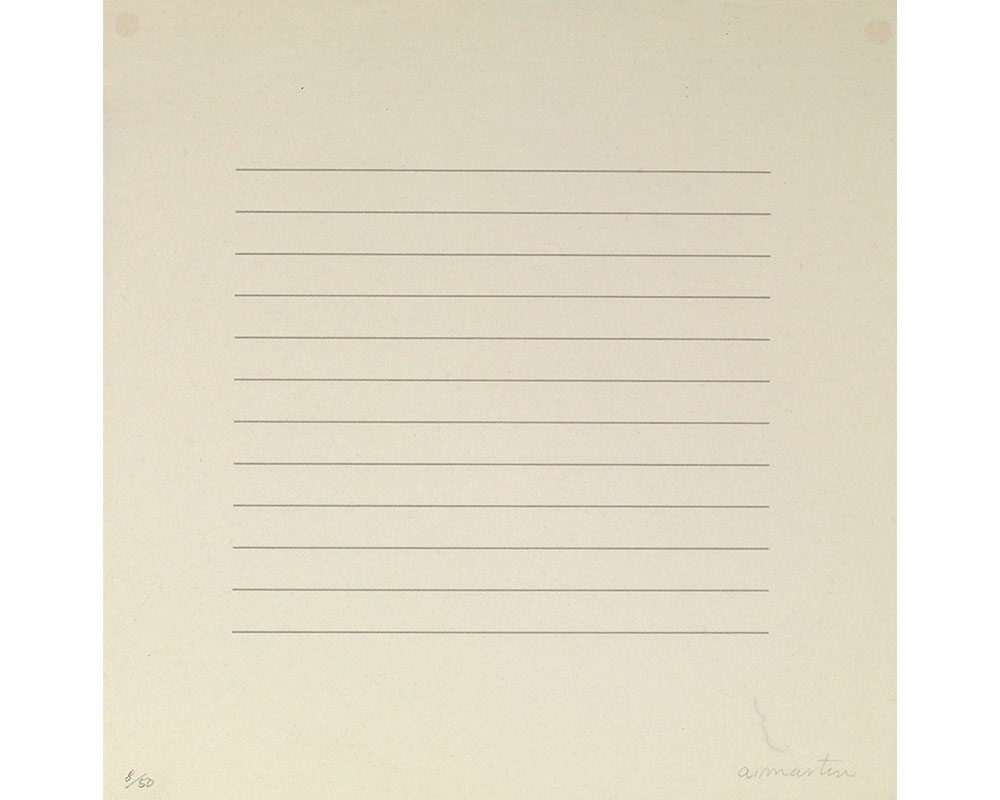
Agnes Martin: On a Clear Day
The enigmatic Canadian-born American artist Agnes Martin spent her long life and career purging her mind and art of all conceptual thoughts, living and working by inspiration alone in the pursuit of beauty and purity. Her paintings, drawings, and prints are most often square-shaped with subtle stripes of white, gray, cream, or light colors arranged horizontally, vertically, or in a grid formation. Martin was part of the Abstract Expressionist generation, yet her work was adopted by the young Minimalists of the 1960s who admired her seemingly objective approach to art-making. While she exhibited alongside the likes of such artists as Donald Judd and Sol LeWitt, she fundamentally disagreed with the Minimalists’ impersonal attitude toward their work. Contrary to their rigorously objective and unfeeling approach, Martin recognized that while nothing in nature (artwork included) could be perfect, her work could evoke the feeling of “transcendental perfection” and exaltation.
In 1967, amidst a wave of recent critical and commercial success, Agnes Martin suddenly left New York City, where she had been living for ten years. She traveled throughout Canada and western America for about a year and a half before putting down her roots in New Mexico, where she built a house by hand and lived in almost complete isolation for the next six years, in which time she made no art whatsoever. At the end of this artistic hiatus in 1973, Martin produced On a Clear Day, an epic series of thirty 12” x 12” screenprints which explore different grid configurations, a common motif in her work. The following year, Martin built a studio and returned to painting.
The SCMA recently acquired one of these remarkable prints, which are often considered to be Martin’s most successful attempt at eliminating all presence of the ego from her art. Martin’s relationship to spirituality and religion was rather complicated. In her writings on art and life, it is clear that she drew inspiration from Zen Buddhism, Taoism, and Christianity, yet she never adhered to any particular belief system exclusively. In the tradition of Zen Buddhist practices, Martin strove for a non-egoic existence and artistic practice in which she emptied her mind to reveal deep-seated inspiration: “You have to wait if you’re going to be inspired. You have to clear out your mind, to have a quiet and empty mind.”
Martin’s artistic practice was contemplative and solitary, which is reflected beautifully in On a Clear Day. The clarity mentioned in the title can easily be interpreted as clarity in the natural world as well as in the mind of the artist. The understated neutral palette and near-perfect lines evoke the sensation of boundless space. “My [artworks] have neither object nor space nor line nor anything – no forms. They are light, lightness, about merging, about formlessness, breaking down form. You wouldn’t think of form by the ocean. You can go in if you don’t encounter anything. A world without objects, without interruption, making a work without interruption or obstacle. It is to accept the necessity of this simple, direct going into a field of vision as you could cross and empty beach to look at the ocean.”